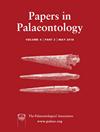Astogenetic morphological variation in the bryozoan Prophyllodictya gracilis from the Middle Ordovician of Russia and inferred colony‐wide feeding currents
IF 2.3
2区 地球科学
Q1 PALEONTOLOGY
引用次数: 0
Abstract
The discovery of a relatively large and complete ptilodictyid bryozoan colony enabled morphometric analysis of astogenetic change from the colony base to the periphery. This enabled us to test the hypothesis that the relative area of feeding and non‐feeding zooids must be relatively constant across astogenetic growth in this colony. The colony is a stenolaemate cryptostome belonging to the cribrate species Prophyllodictya gracilis (Eichwald). It was recovered from the Volkhov Formation (Dapingian Stage of the Middle Ordovician) from the Putilovo Quarry east of St Petersburg, Russia. The colony was digitally imaged so lacuna and branch dimensions could be measured relative to the colony base and colony edge. Branch thickness and width decreased from the colony base to the top of the colony. Lacuna area and the number of autozooecial rows per branch also decreased distally while the number of lacunae per area increased. As a result, there was an astogenetically stable ratio of autozooid‐bearing skeletal branch area to the total lacuna area across the colony. This characteristic is interpreted as a requirement of colony‐wide feeding currents in this cribrate cryptostome colony.俄罗斯中奥陶世苔藓虫的星形发育形态变异及推断的全群落取食流
一个相对较大和完整的拟虫类菌落的发现使得从菌落基部到外围的星形发生变化的形态计量学分析成为可能。这使我们能够验证一个假设,即在这个群体的星形发育过程中,进食和非进食动物的相对面积一定是相对恒定的。该群落是属于棘科植物proyllodictya gracilis (Eichwald)的窄尾隐石。它是在俄罗斯圣彼得堡以东Putilovo采石场的Volkhov组(中奥陶世大坪期)中发现的。对菌落进行数字成像,从而可以测量相对于菌落基部和菌落边缘的空隙和分支尺寸。从菌落底部到菌落顶部,分枝的厚度和宽度逐渐减小。凹穴面积和每枝自生行数也呈纵向减少趋势,而凹穴数量呈纵向增加趋势。结果表明,在整个群体中,具有自动体的骨骼分支面积与总陷窝面积的比例在星形发育上是稳定的。这一特性被解释为在这个cribriate隐石群落中需要整个群体的摄食电流。
本文章由计算机程序翻译,如有差异,请以英文原文为准。
求助全文
约1分钟内获得全文
求助全文
来源期刊

Papers in Palaeontology
PALEONTOLOGY-
CiteScore
4.50
自引率
4.30%
发文量
55
期刊介绍:
Papers in Palaeontology is the successor to Special Papers in Palaeontology and a journal of the Palaeontological Association (www.palass.org). The journal is devoted to the publication of papers that document the diversity of past life and its distribution in time and space.
Papers in Palaeontology is devoted to the publication of papers that document the diversity of past life and its distribution in time and space. As a sister publication to Palaeontology its focus is on descriptive research, including the descriptions of new taxa, systematic revisions of higher taxa, detailed biostratigraphical and biogeographical documentation, and descriptions of floras and faunas from specific localities or regions. Most contributions are expected to be less than 30 pp long but longer contributions will be considered if the material merits it, including single topic parts.
The journal publishes a wide variety of papers on palaeontological topics covering:
palaeozoology,
palaeobotany,
systematic studies,
palaeoecology,
micropalaeontology,
palaeobiogeography,
functional morphology,
stratigraphy,
taxonomy,
taphonomy,
palaeoenvironmental reconstruction,
palaeoclimate analysis,
biomineralization studies.
 求助内容:
求助内容: 应助结果提醒方式:
应助结果提醒方式:


